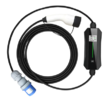Both 4 mm² and 6 mm² would do, I find the two are often around same price, so may as well use 6 mm² there are two types of insulation thermal setting and thermal plastic, so need to look at the charts, I tend to use Batt cables website.
Using a commando socket inside a garage to charge an EV is not really a problem, but using it for a car out doors can be a problem depending on the earthing arrangements, with TT or TN-S not too much a problem, but most supplies are TN-C-S and that presents problems.
We are looking at protection for
loss of PEN and 6 mA DC detection which changes is type A or B RCD's are required, earth mats etc. The charging lead seen here

has a box in the lead which can have variable functions, it can have 6 mA detection built in, but it may also not have it, the same with RCD function, and disconnection with loss of PEN, this can make huge changes into what is needed on the supply to the 32 amp socket.
I would also lean towards the commando socket, as can also be used for welding sets etc. But a proper EV charging point often monitors whole supply and varies charge rate to suit other items used on the property, and I think but not sure on this has to allow the DNO to be able to switch off the charging points when there is high demand.
The installer must ensure it is safe, and when you can change the lead used, the only way is to install all the safety devices in supply to socket, I have not as yet looked into this, but likely needs a auto disconnection device, be it a moulded breaker with a release solinod or a contactor, in other words there's a lot more involved than simply fitting cable and a socket.
I have not seen any single width RCBO's type B, where the type B refers to the RCD not the MCB part of the device, I got caught out, all mine said type B on the packet, but in fact were type AC.
I am not comfortable with switching the earth which is required with some
loss of PEN detection devices I have included the link to the IET wiring matters on loss of PEN.
You need to understand the risks before you can design the system, and having vehicle charged outside or inside makes a huge difference, and even outside, in my own house I can park a vehicle at rear and front of house, at the rear I could switch off the supply before touching the vehicle and not visitors should go near it, but at front any visitors to home need to pass the car, so it needs all the protection for safety of visitors, postman, milkman etc. In regulations terms makes no difference, even the visiting fox is protected, but some one needs the sign the installation certificate and they need the insurance so should it all go wrong, you don't need to sell the house to pay the compensation and fines.
It is all well and good getting an electrician to test and inspect, but he is doing it without knowing what it is being used for, and even if he does, he will not admit it. And unless his insurance covers, likely neither will house insurance.
I don't know all the answers, my EV is charged from a 13 amp socket inside the home, it is only a bike, and it uses a class II supply, so is not the same as a car charger. You need to do the research and find out what needs doing, you have at least asked on here, so you will get some answers, unfortunately some will just say get some one who has taken the EV point training, and will not explain why. But even as an electrical engineer I have not done that course so would not install an EV point without first doing the training.



